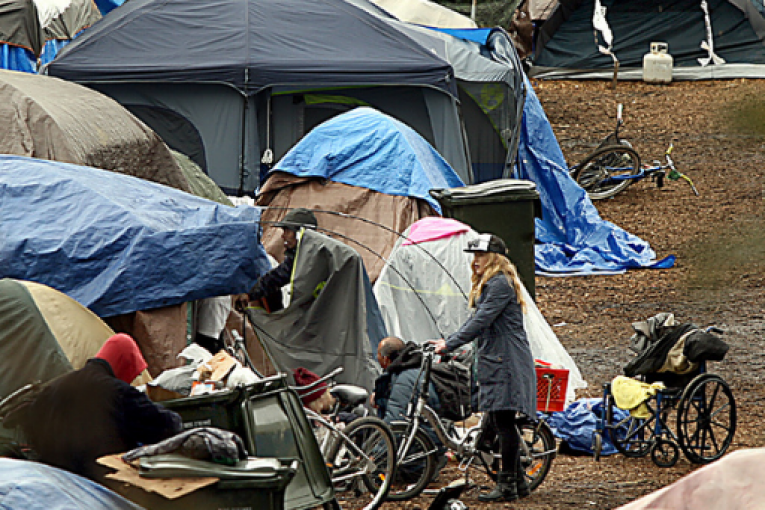

By Ned Resnikoff
Sheriff Cooper and District Attorney Reisig claim to be offering your readers a plan to end homelessness within the next year, but they’re really just selling snake oil. Despite their blithe assertions to the contrary, drug addiction is not the root cause of California’s homelessness crisis, and tougher drug laws will not end homelessness.
In support of their extraordinary claim that their plan can end homelessness in a year, they cite several other states as positive examples. Each of these states, they write, has harsher penalties for drug possession and lower  homelessness; surely the former causes the latter. What Cooper and Reisig neglect to mention is that every one of the states they mention also has more drug overdose deaths per capita than California. Substance abuse is actually a bigger problem in these states than in California, even as homelessness is less of one.
homelessness; surely the former causes the latter. What Cooper and Reisig neglect to mention is that every one of the states they mention also has more drug overdose deaths per capita than California. Substance abuse is actually a bigger problem in these states than in California, even as homelessness is less of one.
The real reason why these states have lower rates of homelessness isn’t a mystery: they have much lower housing costs. According to the most recent Zillow data, the average home in California is now worth nearly $730,000; of the other states mentioned by Cooper and Reisig, the most expensive is New Jersey, where the typical home is still worth just $457,000. Michigan and Illinois both have average home values below $250,000.
The hard fact of the matter is that California will not be able to end homelessness in the space of a year — least of all by simply arresting our way out of the problem. The only real solution begins with ensuring that every Californian has access to decent, stable housing. To end the homelessness crisis, we need to end the housing crisis.
Ned Resnikoff
Policy Director
California YIMBY






I stayed at the beautiful Hilton Hotel in downtown San Francisco last week. I just learned today that the hotel will no longer be paying its mortgage and will go into foreclosure unless it can be sold. The chain says that homelessness, crime and theft are major factors in their decision. Once you walk out the front doors of the Hilton there is a line of homeless people right next door at a food kitchen. There’s garbage and blight everywhere created by the homeless. Why is San Francisco letting a few thousand homeless ruin the city for everyone else?
I read today that the yearly homeless budget for San Francisco is $700 million dollars. There are roughly around 7,700 homeless in S.F. of which almost half are already sheltered. That comes out to near $90,000 per homeless person. Where’s that money going because it doesn’t seem to be doing much to solve the problem?
And yes, most of the homeless that I saw looked drugged out.
“The revised budget for FY22-23 includes $423 million for Permanent Housing, $244 million for Mental Health services, $58 million for Shelter and Hygiene programs, and $120 million for Homelessness Prevention programs.”
Sounds like they should send that money to Michigan or Illinois – where it would go a lot farther.
So my $90,000 per homeless person is actually higher? Where’s the money going when the problem seems to be only getting worse? How much waste is involved? How many people are getting rich off these funds?
I guess I’m not following your point. It seems like the problem is that they don’t have enough funding to house all the people, no? Plus there aren’t nearly enough beds for mental health services in SF (or anywhere else).
My point is throwing over $90,000 per homeless person at the problem SHOULD SOLVE IT. The money isn’t being used properly.
You think so? Based on what kind of analysis?
This was a study of UC Irvine and United Way…
Source: https://www.unitedwayoc.org/wp-content/uploads/2017/03/Orange-County-Cost-Study-Homeless-Executive-Summary.pdf
Being that the average rent in S.F. is $2997/month that would come to $36,000/year still leaving $54,000 in extra funds. And that’s the average rent, not low income rentals. It’s not hard when you do the math to realize that money is going down the drain. Leave it to Democrats to throw $2 at a $1 problem and the problem still never gets better.
That doesn’t tell you anything. You’re looking at the cost of rent, not the cost of supportive housing.
If the cost of supportive housing is more than the actual average rent in S.F. than something really stinks. So what you’re saying defeats your argument that housing costs are the problem if supportive housing costs more than actual housing.
I think we can see where the actual “snake oil” is coming from.
What do you think supportive housing is?
That said, I do think you’re looking at this the wrong way. As I understand it, what San Francisco is attempting to do is build housing for homeless people – i.e. permanent supportive housing. That doesn’t mean they are renting apartments, it means they are building housing units at a cost of $750 to $1 million per unit (the cost of an affordable housing unit). So I don’t think you can be dividing the total budget by person and say the state is spending x amount per year on each homeless person. They are spending a lot up front on housing.
If you look at the budget allocations, most of the costs for homeless is in fact the housing because it’s not just building housing, it’s building housing with subsidized rent and wrap around services.
So people are homeless in San Francisco because of the high cost of housing. But renting an actual apartment for the average rent of $2997/month won’t work because the homeless need much more expensive supportive housing. So how is the cost of actual housing the problem which this article is pointing to?
There are many holes in your argument David.
Again, I think the part that you are missing is you are computing an average from the upfront costs of building housing.
So one day, they’re sitting in their $730,000 home; the next day – they’re out on the street.
Got it.
Or, they’re sitting in their rent-controlled apartment in San Francisco, but suddenly can’t come up with the $500 monthly rent that they secured “back in the day”.
Well, according to the “survey” that David cited yesterday, most of them report that they are “from” the locale where they’re “camping”.
What David isn’t telling you is how accurate that survey is (e.g., how that survey was conducted, how many didn’t or couldn’t respond, etc.).
In any case, it sounds like they should head to Michigan or Illinois. That would be my suggestion.
Actually – I’ve got another one, too: Austin’s housing market is CRASHING (even more than San Francisco’s), after an enormous run-up in housing prices – due to the boom-and-bust cycle those type of places pursue.
“Alternatively” – stick around some of the most-expensive locales in the country – maybe a YIMBY will buy you a house. (I’ve kind of “fancied” Venice Beach, if I ever ended up in that situation. And apparently, so do a lot of homeless people.)